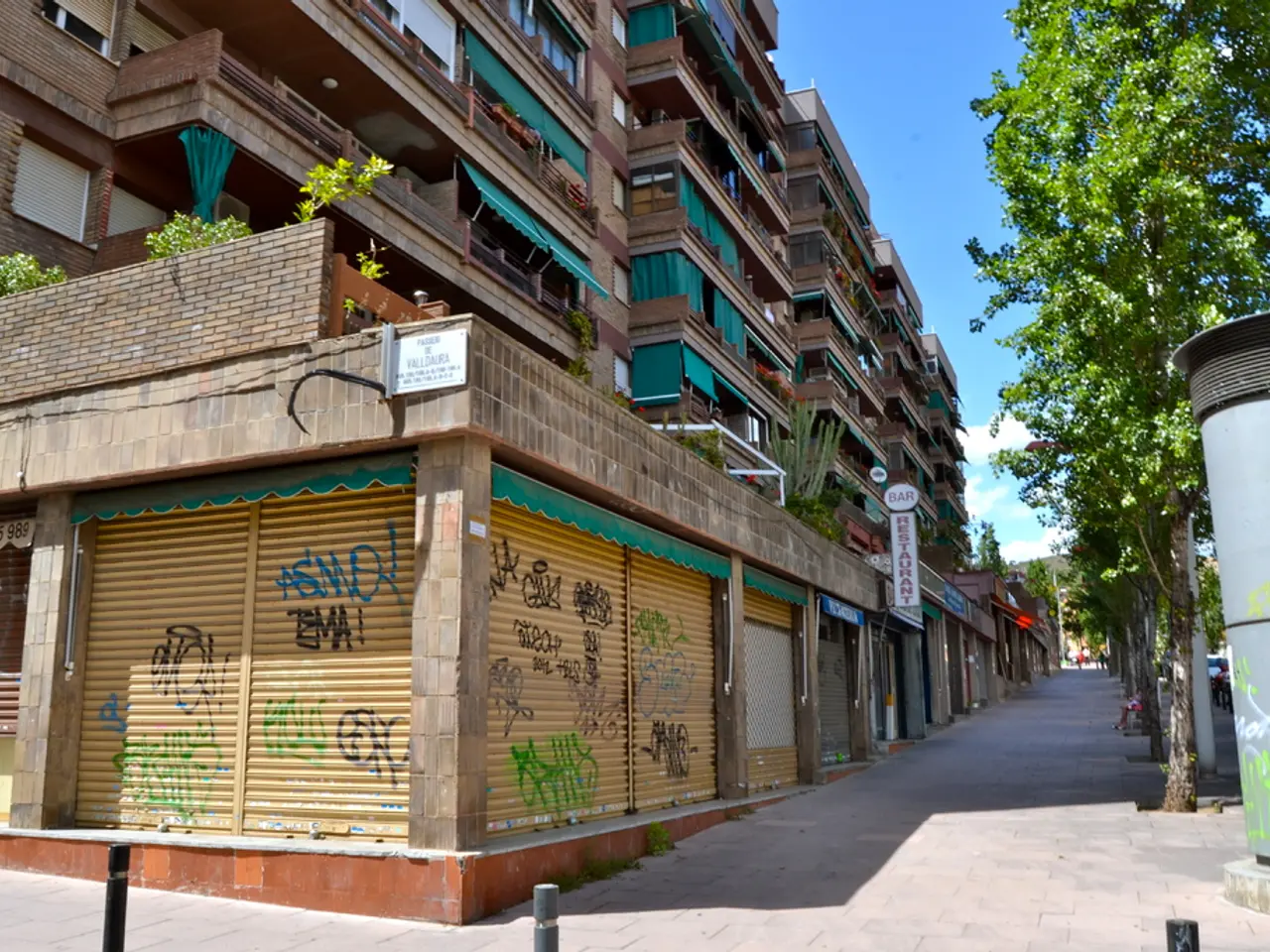London home transforms leftover materials into a striking architectural design statement
In the heart of London, a sustainable garage conversion in Bethnal Green is turning heads with its innovative use of eco-friendly materials. The transformation, showcasing oriented strand board (OSB), terrazzo tile offcuts, and natural linoleum, is redefining urban living aesthetics by combining sustainability with modern design sensibilities.
Traditionally, terrazzo is a composite material that combines stone chips in a cement or resin base. In this home, the bathroom is lined with brightly coloured terrazzo tiles, which are offcuts from a previous project. The linoleum, an eco-friendly flooring choice that has regained popularity, covers the rest of the house.
Linoleum, made from all-natural materials like linseed oil, cork dust, wood flour, and jute backing, offers more than just a sustainable flooring option. It is not only biodegradable but also durable, warm to the touch, and has a distinctive, earthy scent. Choosing linoleum over more common synthetic options demonstrates how sustainable choices can be both practical and sensorial.
The grey linoleum provides a soft counterpoint to the more textured OSB surfaces, lending a warm, textured interior that balances industrial rawness with a tactile, natural feel. OSB, a material made from wood strands bonded with adhesives, further supports sustainability by optimizing wood resources.
This design method promotes a new urban aesthetic where sustainability and style coexist seamlessly. It transforms a typically utilitarian garage space into an inviting, contemporary environment. This approach is not just about minimizing environmental impact, but also about enhancing visual and experiential qualities.
The sustainable conversion in Bethnal Green serves as a replicable model for sustainable, affordable urban housing or workspace solutions. It respects existing structures and reduces construction waste, helping to shape a more responsible and aesthetically progressive way of living in dense city contexts.
The home, listed on The Modern House for £650,000, offers a quiet counter-narrative in a city like London, where space is scarce and architectural polish often reigns supreme. It tells a story not just of what materials cost or how they look, but of the stories they tell and the resources they save. This innovative approach to urban living is a testament to the fact that eco-friendly choices can enhance not only environmental performance but also visual and experiential qualities.
[1] Carmody Groarke textile workshop transformation [2] Another example of sustainable architecture in Bethnal Green [5] More information about sustainable architecture trends in Bethnal Green
[1] The Carmody Groarke textile workshop transformation, similar to the sustainable garage conversion in Bethnal Green, demonstrates innovative uses of eco-friendly materials in design, such as oriented strand board (OSB) and terrazzo tile offcuts.[2] The sustainable architecture movement in Bethnal Green is growing, with notable projects like the garage conversion showcasing the potential for environmental-science principles to guide home-and-garden makeovers, revolutionizing the local fashion-and-beauty and food-and-drink landscapes.[3] Kitchen renovations can incorporate sustainable living practices, too. Recipes using locally sourced, organic ingredients, combined with energy-efficient appliances and eco-friendly countertops like bamboo or recycled glass, can help homeowners minimize their environmental footprint while improving their health-and-wellness.[4] The extension of a home, built with materials like natural linoleum and OSB, promotes sustainable living and offers an opportunity to embrace the philosophy of sustainable-living in lifestyle choices, including cooking methods that prioritize plant-based options and use compostable materials.[6] In the realm of science and climate-change, this renovation project serves as an example of how architectural design can contribute to the global movement towards sustainable living. By focusing on eco-friendly materials and minimizing waste, it offers a solution for environmental-science researchers and activists who also seek a contemporary living space.[7] The popularity of terrazzo tiles in home-and-garden projects is increasing, as their offcuts provide a budget-friendly, sustainable solution for flooring. Their durability and distinct patterns add a touch of fashion-and-beauty to the home, while remaining a practical choice that aligns with the values of sustainable-living.[8] The Bethnal Green sustainable garage conversion also demonstrates the potential for recycled materials to be incorporated into the design of urban spaces. By using offcuts from previous projects like terrazzo tiles, it not only reduces waste but also fosters a circular economy within the design community.[9] With a focus on sustainability, homeowners can curate a unique and desirable kitchen space that emphasizes eco-friendly living, food-and-drink choices, and stylish, modern design. By combining recycled materials with sleek appliances and functional components, it is possible to achieve a balance between aesthetics and practicality in the kitchen.[10] The Bethnal Green sustainable garage conversion presents an opportunity for enthusiasts of home-and-garden projects to learn from its design choices and apply them to their own renovations. By exploring innovative eco-friendly materials like OSB, terrazzo tile offcuts, and linoleum, homeowners can contribute to a more sustainable future while enhancing their living spaces with modern design sensibilities.



